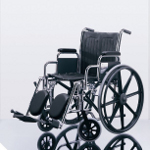The Wheelchair Guide
Your Wheelchair and Mobility Scooter Resource
Prescribing a Wheelchair: Follow Up Care
Monday, July 13th, 2009 at 11:38 am
 When a doctor prescribes a wheelchair to a user, it is very important that the wheelchair fits the needs of the user. It is also very important that the wheelchair user have a great deal of input over the process, because not only must their physical needs be met, but there are a number of other considerations, like where the person intends to primarily use their wheelchair, that should be considered.
When a doctor prescribes a wheelchair to a user, it is very important that the wheelchair fits the needs of the user. It is also very important that the wheelchair user have a great deal of input over the process, because not only must their physical needs be met, but there are a number of other considerations, like where the person intends to primarily use their wheelchair, that should be considered.
It is encouraged that new wheelchair users also talk with experienced wheelchair users and do a good deal of research on their own, because often doctors, while very well meaning, are not very experienced with wheelchairs and have never actually used one for an extended period of time. Due to health and safety concerns, it is very important that the wheelchair fits the physical requirements of the user.
Once the wheelchair arrives, everything should be remeasured and the wheelchair fully evaluated to ensure that it does in fact fit the needs of the user, however the doctors responsibility does not stop here. Instead, the wheelchair and its effect on the user should be reevaluated with each visit to the doctor.
One of the most important things that a doctor should look for is how the wheelchair is affecting the posture of its user. This is often something that can not be seen until after the user has been using the wheelchair for some time. Proper posture is essential for wheelchair users, because overtime a poor sitting position can cause a great number of health problems.
The actual condition of the wheelchair should also be checked and the user should be trained in how to properly maintain and care for their wheelchair. This includes lubricating moving parts, removing and cleaning the components, adjusting the anti-tip casters, and regularly checking the wheelchairs bolts for tightness. Emergency maintenance, such as how to fix a flat tire, should also be shown.
It is also very important that the wheelchair user be trained in how to navigate environmental factors that they might encounter. This includes the ability to move over curbs, navigate steps, and traveling on hills. Proper transfer techniques should also be shown and the user should be trained on how to fall out of the chair and recover. There are several places across the country that offer a sort of wheelchair obstacle course, to help train new wheelchair users and experienced wheelchair users alike.
The doctor should also make sure that the users home area is wheelchair friendly. It may be necessary to widen doors, install ramps, or a wheelchair lift. The doctor should talk with the patient and explain some of the options available.